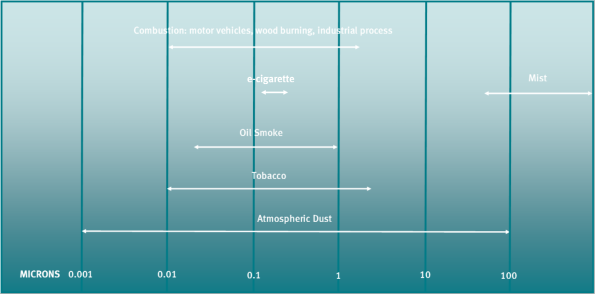The Effects of e-Cigarettes on Smoke Detectors
Since 2007, the use of electronic cigarettes has drastically increased worldwide, and more frequently we are being asked how e-cigarette vapour will affect Hochiki smoke detectors.
In order to understand how e-cigarette vapour will affect a smoke detector, we need to understand the particle size and distribution of aerosols produced by e-cigarettes. The Department of Chemistry at Monmouth University measured the particle size in an undiluted state using a spectral transmission procedure, and found that e-cigarette particles are typically between 0.25 – 0.45 microns, which is comparable to tobacco smoke (as shown on the graph below).

Diagram to show particle sizes (particle sizes obtained from engineering tool box and NCBI).
However, we must bear in mind, that the particles that reach a smoke detector will not be undiluted; they would have mixed with the saliva in the mouth, creating particle sizes more comparable to steam. We must therefore expect e-cigarettes to affect smoke detectors in the same way as steam.
Hochiki are renowned worldwide for manufacturing high quality, robust and reliable smoke detectors. We understand that false alarms are both disruptive and expensive, and as such we have incorporated a number of features in both our conventional and analogue smoke detectors that help protect against false alarms.
For example, Hochiki detectors contain a honeycomb structured mesh that has been specifically designed to maximise smoke flow, and improve tolerance against insects, dust and steam. If steam comes into contact with the mesh, the steam is forced to diffuse through the mesh resulting in dissipation of steam particles, thus reducing false alarms caused by steam.

By making the aperture smaller (0.4mm), narrowing the distance between apertures
(0.05mm) and widening the effective aperture ratio, it maximises the smoke flow and
improves tolerance against insects, dust and steam.
Furthermore, Hochiki smoke detectors work using optical technology; i.e. if smoke enters the chamber it will cause the infrared light to scatter and the device will go into alarm. In order to protect against false alarms, Hochiki devices use an optimum scattering angle between the infrared LED and the Photo Diode which reduces sensitivity towards steam and oil.
In conclusion…
There have been very few reports of e-cigarettes causing problems with smoke detectors. If you have purchased your smoke detector from a reputable manufacturer such as Hochiki, it is unlikely that a small amount of e-cigarette vapour will cause your device to go into alarm. Of course, if someone is standing directly under a detector and creating a generous amount of e-cigarette vapour, then the density of particles entering the chamber is likely to cause any smoke detector to go into alarm.
Whilst Hochiki devices are already considered to be amongst the most reliable in the world, our research and development department continue to experiment with the most innovative technology for use in future generations of Hochiki devices. This will guarantee that Hochiki devices continue to be some of the most robust and reliable devices on the market.
Resources:
https://hochikiblog.com/
http://www.engineeringtoolbox.com/particle-sizes-d_934.html
http://www.ncbi.nlm.nih.gov/pubmed/23216158